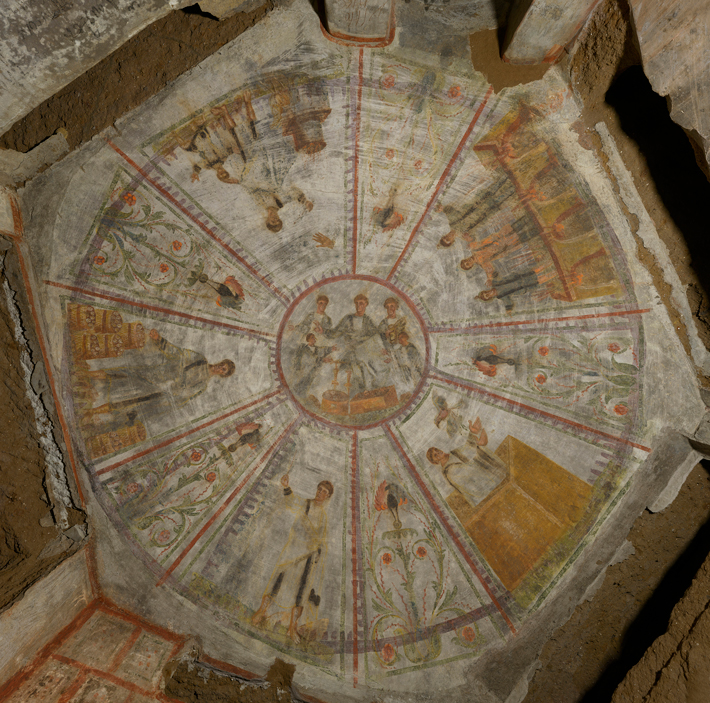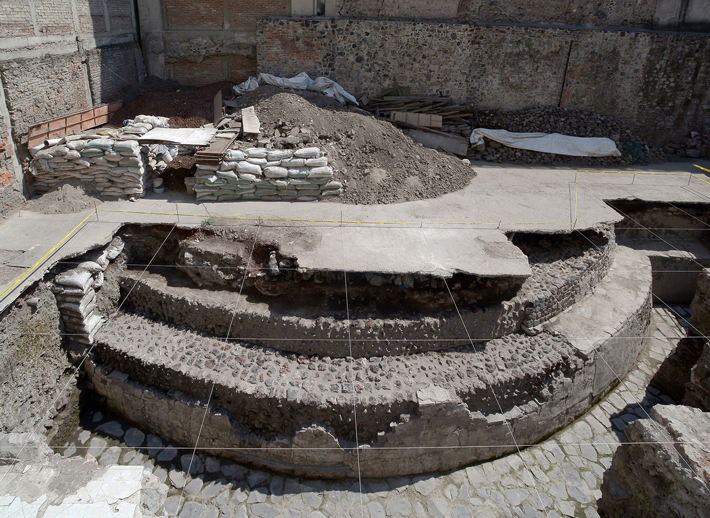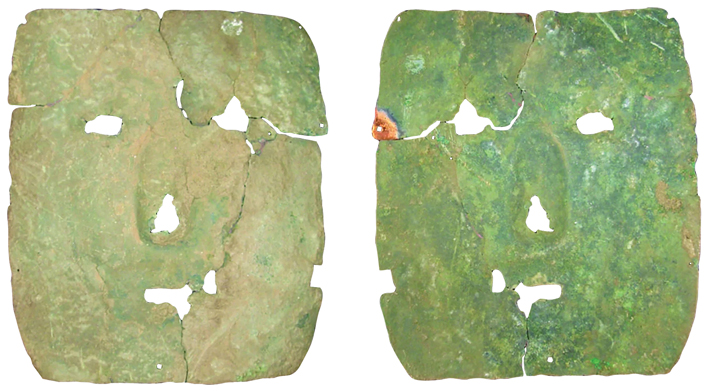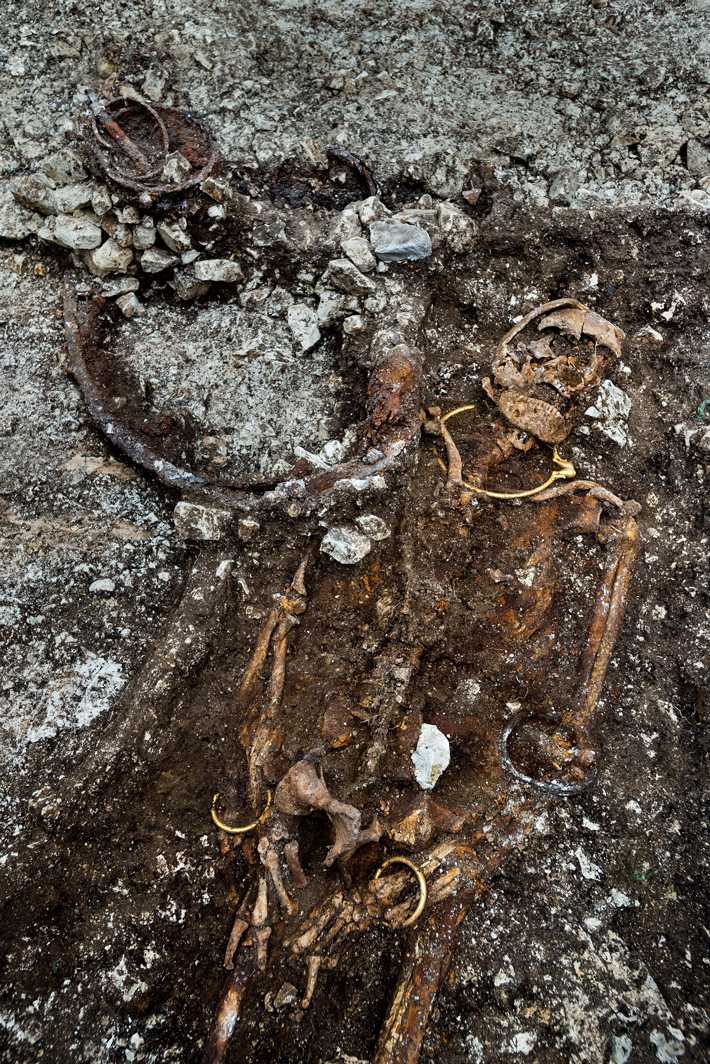From the Trenches
Not by Bread Alone
By ROSSELLA LORENZI
Monday, August 14, 2017

Deep in the heart of Rome’s largest catacombs, laser beams have unveiled stunning 1,600-year-old early Christian frescoes. Mixing pagan symbols with Christian images, the paintings adorn the ceilings and walls of two burial chambers in the Catacombs of Domitilla, a labyrinth of tunnels and tombs stretching over 10 miles beneath Rome near the ancient Appian Way. The crypts, carved out of volcanic tufa, were created for wealthy merchants involved in the imperial grain trade and the production of bread. They were painted around A.D. 360, a few decades after the emperor Constantine declared Christianity legal. “The chambers have long been known, but laser cleaning has removed centuries of grime, algae, and chalk, revealing elaborate scenes and new findings,” says Fabrizio Bisconti, the superintendent in charge of catacombs for the Vatican’s Pontifical Commission for Sacred Archaeology.
Led by Barbara Mazzei, restorers have been able to remove not just the black patina but also graffiti covering the frescoes. Old pagan symbols of the afterlife such as peacocks, scenes from the Old and New Testaments, and depictions of the grain trade have emerged for the first time. Such a mixture of symbols reveals the difficult shift suffered by wealthy Romans as they slowly abandoned their pagan beliefs to embrace the new Christian religion in the fourth century A.D. Says pontifical commission head Cardinal Gianfranco Ravasi, “These tombs represent the roots of Rome and of Christianity.”
Capital Gains
By MARLEY BROWN
Monday, August 14, 2017

Archaeologists working in downtown Mexico City have uncovered sections of a large circular temple dedicated to the Aztec god of wind, Ehecatl, and part of a ritual ball court, that date to just before the Spanish conquest in the late fifteenth century. The team also encountered a chilling collection of 32 male neck vertebrae that researchers believe was an offering associated with the ball game. Future excavations could reveal more ritual and governmental spaces believed to have been built during the 1486–1502 reign of Aztec emperor Ahuizotl, the predecessor of Moctezuma, and will prove integral in confirming surviving Spanish descriptions of the Aztec capital, Tenochtitlán.
Fast Food
By MARLEY BROWN
Monday, August 14, 2017
An interdisciplinary study has determined that modern chickens only developed several of their most prized domestic traits within the last 1,000 years. A British team made up of archaeologists, geneticists, statisticians, and historians made the discovery by sequencing ancient DNA from chicken bone samples collected at archaeological sites across Europe, whose dates range from Roman times through the postmedieval period, and creating a model that pinpoints when specific chicken genes began to change. Though humans first domesticated jungle fowl in Asia around 6,000 years ago, it was only in the High Middle Ages that chickens began to consistently display both a lack of aggression and the capacity to lay eggs more regularly. According to Liisa Loog of the University of Oxford, a lead author of the study, one individual genetic variant may be responsible. “This particular mutation we’re looking at has been shown in modern chickens to both make them friendlier and enable them to lay eggs earlier on in the breeding season,” she says.
Humans, of course, favored these cooperative chickens and, unwittingly, exerted selective pressure that perpetuated their genes. To understand why chickens evolved so rapidly, Loog and her colleagues point to the spread of Christianity throughout Europe a thousand years ago, when dogmatic prohibitions on the consumption of four-legged animals and fasting rituals may have increased the demand for poultry. “Every time we see a transformation like this we just assume that it must have taken a very long time to happen,” says Loog. Instead, it seems that a widespread and rapid shift in the dietary behavior of large populations accelerated the kind of evolutionary change in chickens that is often imagined to occur over millennia. Loog explains, “It kind of shows you don’t really need to know much about genetics to make genetically modified organisms.”
Andean Copper Age
By ERIC A. POWELL
Monday, August 14, 2017

New radiocarbon dates show that a mask discovered in a valley in northwest Argentina is the oldest worked copper artifact ever found in the Andes. The 3,000-year-old mask, which depicts a stylized human face, was discovered in the grave of a man who lived at a time when Andean peoples were first beginning to practice agriculture. Scholars had generally believed metallurgy in the New World was first developed in Peru and then spread to the rest of South America. But the mask challenges that assumption, says University of Buenos Aires archaeologist Leticia Inés Cortés, who led the team that studied the artifact. “Since complex societies later emerged in what is now Peru, there is a tendency to assume that all technological innovations did too,” says Cortés. “The mask shows that there was not one place for innovation in metalworking, but many, including this region of the southern Andes.”
A Princely Update
By JASON URBANUS
Monday, August 14, 2017
 In 2015, French officials announced the discovery of an exceptional Celtic burial located in Lavau, Champagne. The fifth-century B.C. tomb contained a wealthy individual—likely a prince—surrounded by a luxurious assemblage of personal items and drinking vessels (“Top 10 Discoveries: Tomb of a Highborn Celt,” January/February 2016). Now, two years later, laboratory analysis of those artifacts has begun to reveal just how truly extraordinary the burial is. Scientists from the Center for Research and Restoration of the Museums of France recently examined objects from the grave using a host of modern techniques, including X-ray tomography and radiography, 3-D imaging, and chemical analysis—a rare opportunity to employ the newest technologies on objects taken recently from the ground, as opposed to those that have been deteriorating in storerooms for decades, or those that have already undergone conservation procedures. Radiography showed that the prince’s belt was embroidered with fine silver threads that formed a continuous frieze of Celtic motifs, the only one of its kind ever discovered. His knife sheath was decorated with bronze thread. Closer examination of the metal vessels revealed their remarkable quality and the skill of the ancient metallurgists, who had mastered the smelting and engraving process. High-resolution 3-D scanning was even able to identify signs of subtle wear on a gold torc caused by its contact with human skin or clothing.
In 2015, French officials announced the discovery of an exceptional Celtic burial located in Lavau, Champagne. The fifth-century B.C. tomb contained a wealthy individual—likely a prince—surrounded by a luxurious assemblage of personal items and drinking vessels (“Top 10 Discoveries: Tomb of a Highborn Celt,” January/February 2016). Now, two years later, laboratory analysis of those artifacts has begun to reveal just how truly extraordinary the burial is. Scientists from the Center for Research and Restoration of the Museums of France recently examined objects from the grave using a host of modern techniques, including X-ray tomography and radiography, 3-D imaging, and chemical analysis—a rare opportunity to employ the newest technologies on objects taken recently from the ground, as opposed to those that have been deteriorating in storerooms for decades, or those that have already undergone conservation procedures. Radiography showed that the prince’s belt was embroidered with fine silver threads that formed a continuous frieze of Celtic motifs, the only one of its kind ever discovered. His knife sheath was decorated with bronze thread. Closer examination of the metal vessels revealed their remarkable quality and the skill of the ancient metallurgists, who had mastered the smelting and engraving process. High-resolution 3-D scanning was even able to identify signs of subtle wear on a gold torc caused by its contact with human skin or clothing.
Advertisement
Advertisement
IN THIS ISSUE
From the Trenches
White Horse of the Sun
Off the Grid
Doll Story
Freeze Frame
Last Stand of the Blue Brigade
Where There’s Coal…
Reading Invisible Messages
Disposable Gods
A Princely Update
Fast Food
Andean Copper Age
Capital Gains
Not by Bread Alone
Advertisement

Recent Issues
-
 May/June 2024
May/June 2024
-
 March/April 2024
March/April 2024
-
 January/February 2024
January/February 2024
-
 November/December 2023
November/December 2023
-
 September/October 2023
September/October 2023
-
 July/August 2023
July/August 2023
-
 May/June 2023
May/June 2023
-
 March/April 2023
March/April 2023
-
 January/February 2023
January/February 2023
-
 November/December 2022
November/December 2022
-
 September/October 2022
September/October 2022
-
 July/August 2022
July/August 2022
-
 May/June 2022
May/June 2022
-
 March/April 2022
March/April 2022
-
 January/February 2022
January/February 2022
-
 November/December 2021
November/December 2021
-
 September/October 2021
September/October 2021
-
 July/August 2021
July/August 2021
-
 May/June 2021
May/June 2021
-
 March/April 2021
March/April 2021
-
 January/February 2021
January/February 2021
-
 November/December 2020
November/December 2020
-
 September/October 2020
September/October 2020
-
 July/August 2020
July/August 2020
-
 May/June 2020
May/June 2020
-
 March/April 2020
March/April 2020
-
 January/February 2020
January/February 2020
-
 November/December 2019
November/December 2019
-
 September/October 2019
September/October 2019
-
 July/August 2019
July/August 2019
-
 May/June 2019
May/June 2019
-
 March/April 2019
March/April 2019
-
 January/February 2019
January/February 2019
-
 November/December 2018
November/December 2018
-
 September/October 2018
September/October 2018
-
 July/August 2018
July/August 2018
-
 May/June 2018
May/June 2018
-
 March/April 2018
March/April 2018
-
 January/February 2018
January/February 2018
-
 November/December 2017
November/December 2017
-
 September/October 2017
September/October 2017
-
 July/August 2017
July/August 2017
-
 May/June 2017
May/June 2017
-
 March/April 2017
March/April 2017
-
 January/February 2017
January/February 2017
-
 November/December 2016
November/December 2016
-
 September/October 2016
September/October 2016
-
 July/August 2016
July/August 2016
-
 May/June 2016
May/June 2016
-
 March/April 2016
March/April 2016
-
 January/February 2016
January/February 2016
-
 November/December 2015
November/December 2015
-
 September/October 2015
September/October 2015
-
 July/August 2015
July/August 2015
-
 May/June 2015
May/June 2015
-
 March/April 2015
March/April 2015
-
 January/February 2015
January/February 2015
-
 November/December 2014
November/December 2014
-
 September/October 2014
September/October 2014
-
 July/August 2014
July/August 2014
-
 May/June 2014
May/June 2014
-
 March/April 2014
March/April 2014
-
 January/February 2014
January/February 2014
-
 November/December 2013
November/December 2013
-
 September/October 2013
September/October 2013
-
 July/August 2013
July/August 2013
-
 May/June 2013
May/June 2013
-
 March/April 2013
March/April 2013
-
 January/February 2013
January/February 2013
-
 November/December 2012
November/December 2012
-
 September/October 2012
September/October 2012
-
 July/August 2012
July/August 2012
-
 May/June 2012
May/June 2012
-
 March/April 2012
March/April 2012
-
 January/February 2012
January/February 2012
-
 November/December 2011
November/December 2011
-
 September/October 2011
September/October 2011
-
 July/August 2011
July/August 2011
-
 May/June 2011
May/June 2011
-
 March/April 2011
March/April 2011
-
 January/February 2011
January/February 2011
Advertisement






